Author Joyce Lyth
Chinchillas by the Bay
“Emergency Evacuation Kits” for our Chinchillas,
Are You Prepared?
Hurricane Katrina was just devastating. After hearing about the thousands of animals left homeless, it really makes you wonder if your family is prepared to evacuate your home for any emergency if necessary. Have you thought about your pets? Are you prepared to just pack up and go, safely taking them with you. Some people may have too many chinchillas to pack up and leave home. If you do, have you thought about what you will need if you are stuck at home without power or the ability to buy supplies? Do you have a generator to provide power, heat, or air conditioning? Do you have enough food and bottled water to last for an extended period of time? All these are important questions.
My family was not prepared, but now we are. After doing some thinking and research, I’ve put together an “Emergency Evacuation Checklist” for chinchilla owners. Hopefully this will give you some ideas and guidelines to follow.
It just so happens that my family lives on the Virginia coastline, the Bay is my very backyard. In the 17 years we have lived here, several hurricanes have come through and there have been a couple of voluntary evacuations. When Hurricane Isabel came through a few years ago, we were hit very hard. We rode the storm out, but what if next time we can’t. I wanted to be fully stocked and prepared to pack up all of our animals and go. We currently have 17 chinchillas, 5 cats, 2 dogs, and 3 hamsters. Our animals are family so every one of them would come with us. My husband went so far as to buy an RV after Isabel, which would make it easier to load up the zoo and take off if necessary. We now have a place to house the chins if we lose our power again; Isabel left us without power and in the heat for weeks. We were lucky to have a generator.
Now remember, the idea is to get your animals out safely and be able to provide for them. The cages and supplies do not have to be state of the art by any means! Cages can be the size and style of your choice. All supplies will depend on what you may already own, what you can find, and what you’ll be able to afford. Please use your judgment as far as chin safety goes. My lists and photos of supplies are helpful suggestions and to be used as a guideline to follow. All of our supplies will vary.
The following is a General Supply List that may help you.
• Travel crates
• Water bottles
• Chinchilla Pelleted Food
• Timothy Hay and Hay Cubes
• Bottled / Jugs of Drinking Water
• Small Food Bowls for Pellets
• Hanging Treat / Hay Balls for Hay
• Treats and Chews
• Bedding
• Dust Bath Containers and Dust
• Small Animal Exercise Pen
• 15” Exercise Wheel
• Small Huts or Chube Tubes for hiding
• Trash Bags
• Antibac Wet Ones Hand wipes / Baby wipes
• Ziploc Bags & Containers to store supplies
• Paper Towels
• Medical Supplies
• First Aid Kit
I prefer the 24” crate (see Photo) for its size. Especially for my duos and set of triplets that are housed together and would travel together as well. This 24” cage is made by All Living Things. It also comes in different cage sizes and wire spacing. I have also pictured (see photo) a very small travel crate that I use when a chinchilla visits the vet. This crate is approximately 8” x 12” The cage size will be left up to the individual buying and using it. I guess it all depends on many things including your budget, how many chinchillas you will be taking, and how much space you have in your vehicle.
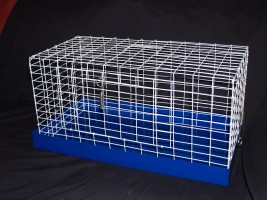 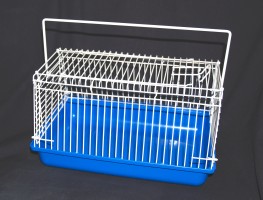
This little water bottle (see photo) is small, but a great travel size. It mounts on the outside of the cage with only the stainless steel tube going into the cage so the bottle cannot be chewed. For home use, I use the glass Lixit bottles, but I think it would be difficult to remove all of them from several cages if I was trying to plan a quick departure! Always remember, when traveling and in route remove the water bottle from the side of the crate so it will not drip the entire time and leave your chin with soaked bedding and no water!
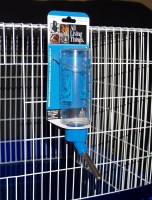
Pellet food can be taken in the bag it comes in or it can be divided into Ziploc storage baggies. I would just take hay in the bag/box it comes in, usually vented to prevent any mold growth. If you must divide it, put the hay in boxes or paper bags. Never store hay in sealed plastic air tight containers or Ziplocs. We always have bottled drinking water at our house. I would definitely purchase the gallon jugs or cases of bottled water to take.
The little bowls (see photo) have come in handy! They can be attached to the cage to avoid food spilling while traveling. They are stainless steel and were purchased in the bird department of a pet store. One screws onto the cage wire and the other can be hung on the cage wire. The hanging treat ball is excellent to stuff with timothy hay. My older chins all have one of these! For travel it can keep hay up off the crate floor and from being tossed around the car. Take caution when using these with young chins. They will try to put their head between the wire openings and climb in!
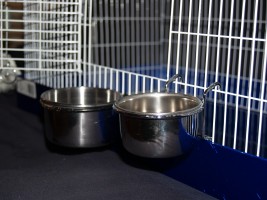 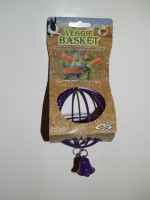
Treats and chews to take with you are basically what your chin is used to at home. Just make sure you don’t forget the chews to keep their teeth filed down. Dust bath containers to take along can be as simple as a small plastic cat box or a shoe box, available at the dollar store! Just do not leave them in the crate for the chin to chew.
My chins all have wheels in their cages here, and they are also used to some playtime out of the cage as well. I would definitely throw one or two of the expandable X-pens and a wheel in the RV (see photo). This is the Small Animal Exercise Pen Model 100-29, by Midwest Homes for Pets. I have attached the 15’ CHIN SPIN Wheel to the side. This would allow your chins to come out of their small crates to play every now and then.
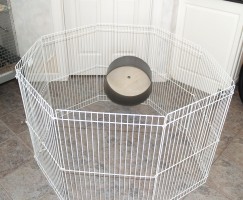
Huts or hideouts are very important offering a shelter for your chin. We never know how long we may be away from home. It could be overnight or for an extended period of time. Trash bags for cleanups and baby wipes / paper towels to clean up trays are important. Rinse baby wipe residue with a wet paper towel and dry well before bedding is put in.
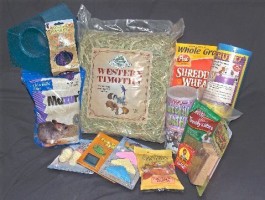 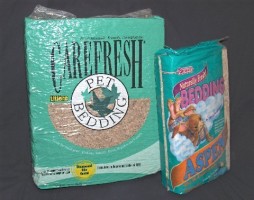
If we ever did need to evacuate I would just grab my entire chin medicine/First Aid chest to take with me. Some of it may be needed and some not, but better safe than sorry. I keep it all in a small Rubbermaid container. This is what I have on hand right now.
• Neosporin / antibiotic ointment
• Q-tips
• Cotton balls or pads
• Sterile gauze
• Bandage tape
• Alcohol
• Hydrogen Peroxide
• Pedialyte
• Panacure and Baytril
• Syringes for mouth feeding and giving medicine
• Critical Care
• Nutri-Cal
• Bene-Bac
• Antibiotic eye ointment
• Natural Tears for eye washes
• Cell phone
• Emergency numbers for veterinarians
• Chinchilla Records
• Chinchilla Books such as “Best of Chinchilla Community Magazine 2000-2003” and “The Joy of Chinchillas”.
I am also including lists of medical supplies that I received from two other people and would like to thank them for their contributions: Lori Earle and Dawnna at Chocolate Chinchillas. I would also like to thank Jamie Huggins and Sarah Romero for their input.
From Lori Earle:
A couple of medications I keep on hand that I’ve found to be very helpful are infant simethicone, children’s kaopectate (kaolin/pectin formula only - you have to get this thru a vet now) and preservative free artificial tears (helps flush out dust from eyes after a bath - I have a couple of chins that need help with that).
With my vet’s approval, I always keep some Trimethaprim Sulfa and Reglan on hand.
From Dawnna at Chocolate Chinchillas:
In a Chinchilla Emergency Kit, THE MOST important item would be Life Line.
No one with a Chinchilla should EVER be without it.
Others would be these...
Albon - To treat diarrhea/ feed store
Antibiotic cream - For minor cuts/ drug store
Charcoal - balances ph in the gut/ pet store or health food store
Desenex - fungus prevention & treatment / drug store
Dyne - high calorie supplement for weak kits & ill chins /Online
Eye Wash - drug store
Lube - for hair ring checks online/store
Ophthalmic Ointment - drug store
Q-tips - cleaning eyes, females, etc. /drug store
Shredded Wheat Biscuits - diarrhea/ store
Simethicone - Bloat/drug store
Also from Dawnna at Chocolate Chinchillas:
Dyne- kits, ill chins, high calorie supplement/Online
Baby Oat Cereal - same/ grocery store
Powdered Goat Milk - kit formula/ online
Electrolyte dehydration / feed store
Acidophilus- everything feeds on bacteria in the gut/ health food store
Charcoal balances ph in the gut/ pet store or health food store
Shredded Wheat diarrhea/ store
Albon diarrhea/ feed store
Lube for hair ring checks online/store
Q-tips cleaning eyes, females, etc. /drug store
Cotton Squares whatever/ drug store
Alcohol cleaning, sterilizing / drug store
Lavender oil minor cuts or abrasions/ health food store
Eye Wash drug store
Ophthalmic Ointment drug store
Antibiotic cream anything/ drug store
Desenex prevent fungus / drug store
Grooming Combs on line
Lidocaine - unavailable/ med supply
Needles - med supply
Syringe - injecting anesthetic - med supply
Gauze - drug store
Medical tape - drug store
Tissue scissors - amputations, necropsies / med supply
Scalpel - necropsy / med supply or hard ware store
Wire cutters - anterior teeth trim/ hard ward store
Cheek retractor - to check molars / craft store
|
|